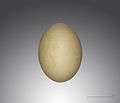Namaqua dove
The Namaqua dove (Oena capensis) is a small pigeon. It is the only species in the genus Oena. It is found over much of Sub-Saharan Africa as well as Arabia and Madagascar.
| Namaqua dove | |
|---|---|
 | |
| Male at Arusha, Tanzania | |
.jpg) | |
| Female at Mapungubwe National Park | |
| Scientific classification | |
| Kingdom: | Animalia |
| Phylum: | Chordata |
| Class: | Aves |
| Order: | Columbiformes |
| Family: | Columbidae |
| Genus: | Oena Swainson, 1837 |
| Species: | O. capensis |
| Binomial name | |
| Oena capensis (Linnaeus, 1766) | |
| Synonyms | |
|
Columba capensis Linnaeus, 1766 | |
Taxonomy
In 1760 the French zoologist Mathurin Jacques Brisson included a description of the Namaqua dove in his six volume Ornithologie based on a specimen collected near the Cape of Good Hope in South Africa. He used the French name La tourterelle du Cap de Bonne Espérance and the Latin Turtur capitis bonae spei.[2] Although Brisson coined Latin names, these do not conform to the binomial system and are not recognised by the International Commission on Zoological Nomenclature.[3] When in 1766 the Swedish naturalist Carl Linnaeus updated his Systema Naturae for the twelfth edition, he added 240 species that had been previously described by Brisson.[3] One of these was the Namaqua dove which he placed with the other pigeons in the genus Columba. Linnaeus included a brief description, coined the binomial name Columba capensis and cited Brisson's work.[4] The specific name capensis denotes the Cape of Good Hope.[5]
The Namaqua dove is placed in its own genus Oena that was introduced by the English naturalist William John Swainson in 1837.[6][7] The genus name is from the Ancient Greek oinas meaning "pigeon".[8]
Two subspecies are recognised:[7]
Description
The Namaqua dove is a tiny sparrow-sized pigeon, typically 22 cm in length with a 28–33 cm wingspan, and weighing 40g. It has a very long black tapered tail, and the size and shape have led to comparison with the budgerigar. The plumage is mostly grey apart from a white belly, and chestnut primary feathers which are visible in flight.
The adult male has a yellow and red beak and a black face, throat and breast. The adult female lacks the black and has a red-based grey bill. Young birds are dark blotched on the wings and shoulders, and otherwise resemble the females.
The song is a quiet, short, double hoo, higher on the longer second note kuh-whooo, mournful and frequently repeated.
Distribution and habitat
The dove is a widespread resident breeding bird in Sub-Saharan Africa and Madagascar with its range extending into the Arabian Peninsula southern Israel, Jordan and as far north as Turkey. It is found in near desert with acacia and bushes. The namaqua dove is prone to wander out its original range, it is now being recorded south Asian countries. In Pakistan this species is recorded near shore waters off Paradise Point, Karachi on Friday, 14 October 2016. In India a female namaqua dove is recorded at khijadiya bird sanctuary near jamnagar,Gujarat on 17 December 2017[9] However, the bird is thought to be in trade in India, and a cage escapee can not be denied for its record from Western India.
Behaviour
The dove is quite terrestrial, and usually forages on open ground and roadsides. The food is almost exclusively minute seeds, such as those of grasses, sedges and weeds. It is not gregarious, being encountered singly or in pairs, though they may form larger flocks at waterholes. The flight is fast with clipped beats and a tendency to stay low. It builds a stick nest in a bush, and lays two white eggs, which are incubated for 16 days in typical pigeon fashion; the female at night and early morning and the male from mid morning till late afternoon.
Gallery

Egg of Oena capensis .jpg)
An immature bird _male.jpg)
Male at Tswalu Kalahari Reserve %2C_crop.jpg)
Male in flight _male_perched_at_night.jpg) male O. c. aliena perched at night, Madagascar
male O. c. aliena perched at night, Madagascar
References
- BirdLife International (2012). "Oena capensis". IUCN Red List of Threatened Species. 2012. Retrieved 26 November 2013.CS1 maint: ref=harv (link)
- Brisson, Mathurin Jacques (1760). Ornithologie, ou, Méthode contenant la division des oiseaux en ordres, sections, genres, especes & leurs variétés (in French and Latin). Volume 1. Paris: Jean-Baptiste Bauche. pp. 120–121, Plate 9 fig 2. The two stars (**) at the start of the section indicates that Brisson based his description on the examination of a specimen.
- Allen, J.A. (1910). "Collation of Brisson's genera of birds with those of Linnaeus". Bulletin of the American Museum of Natural History. 28: 317–335.
- Linnaeus, Carl (1766). Systema naturae : per regna tria natura, secundum classes, ordines, genera, species, cum characteribus, differentiis, synonymis, locis (in Latin). Volume 1, Part 1 (12th ed.). Holmiae (Stockholm): Laurentii Salvii. p. 286.
- Jobling, James A. (2010). The Helm Dictionary of Scientific Bird Names. London: Christopher Helm. p. 89. ISBN 978-1-4081-2501-4.
- Swainson, William John (1837). On the Natural History and Classification of Birds. Volume 2. London: John Taylor. p. 301.
- Gill, Frank; Donsker, David; Rasmussen, Pamela, eds. (2020). "Pigeons". IOC World Bird List Version 10.1. International Ornithologists' Union. Retrieved 15 March 2020.
- Jobling, James A. (2010). The Helm Dictionary of Scientific Bird Names. London: Christopher Helm. p. 280. ISBN 978-1-4081-2501-4.
- Trivedi A. and Trivedi K. 2018.Sighting of Namaqua Dove near Jamnagar, a first record for India. Flamingo 16(1):2-3
External links
| Wikimedia Commons has media related to Oena capensis. |
| Wikispecies has information related to Oena capensis |
- Namaqua dove - Species text in The Atlas of Southern African Birds
